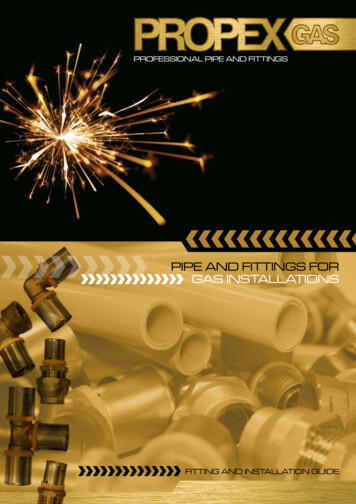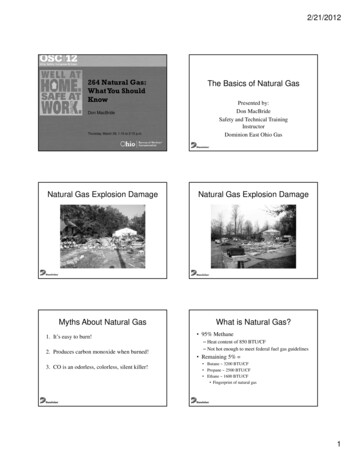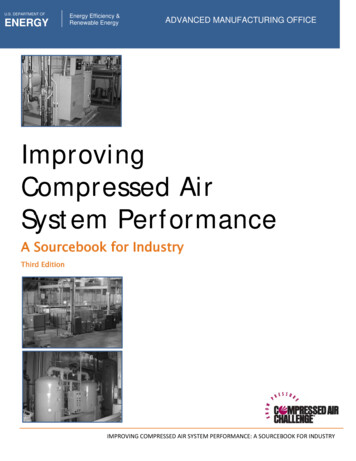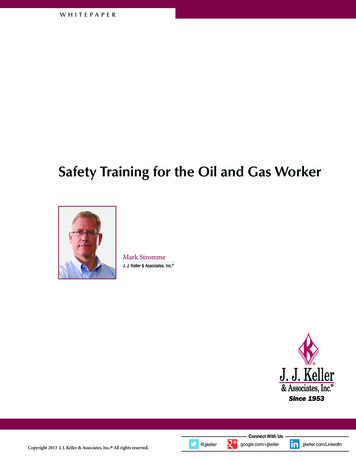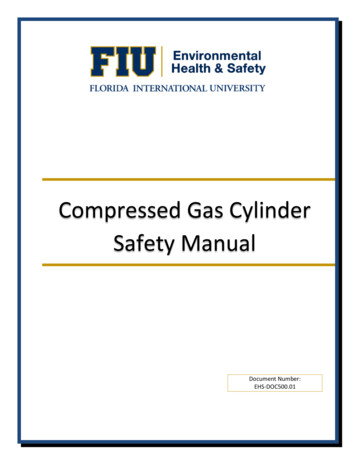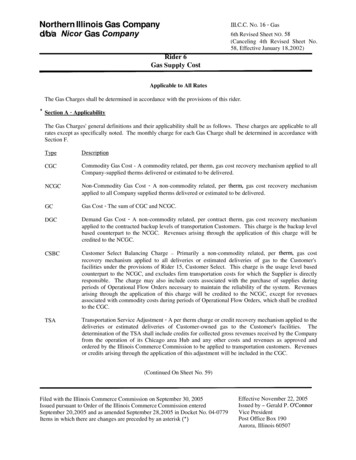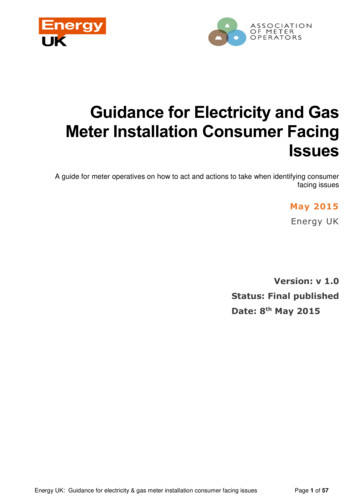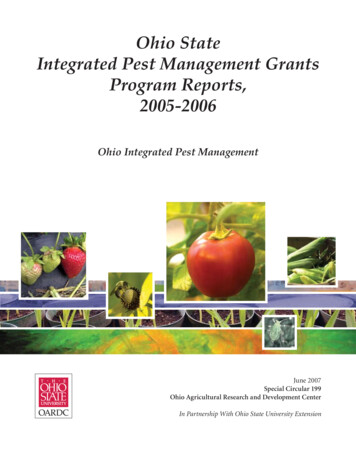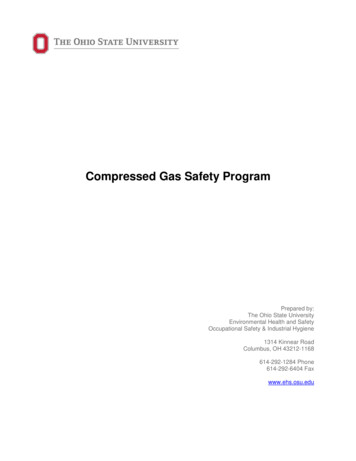
Transcription
Compressed Gas Safety ProgramPrepared by:The Ohio State UniversityEnvironmental Health and SafetyOccupational Safety & Industrial Hygiene1314 Kinnear RoadColumbus, OH 43212-1168614-292-1284 Phone614-292-6404 Faxwww.ehs.osu.edu
Page 2Table of Contents1.0Introduction. 32.0Responsibilities . 33.0Definitions . 44.0Personal Protective Equipment . 55.0Inspection Procedures . 56.0Handling Procedures . 57.0Storage Procedures . 68.0Usage Procedures . 79.0Tubing and Piping Connections . 810.0 Regulators and Valves . 911.0 Other Considerations for Compressed Gas Cylinders . 912.0 Compressed Gas Types . 913.0 Emergency Procedures . 1010.0 Training & Recordkeeping. 10Appendix A: Compressed gas cylinder inspection checklist . 11Compressed Gas Safety ProgramUpdated 2016
Page 31.02.0Introduction1.1It is the policy of The Ohio State University (OSU) to take precautions to eliminate potentialhazards in the workplace. The purpose of this Compressed Gas Safety Program is toprovide the hazards associated with compressed gases and outline the steps to take toensure employees who work with, or around compressed gases are not exposed to hazards;and to provide procedures for common compressed gas work duties to minimize exposure inaccordance with the OSHA Hazardous Materials, Compressed Gas standards (29 CFR1910.101); Department of Transportation Hazardous Materials Regulations; and CompressedGas Association (CGA) guidelines.1.2Compressed gas cylinders can present a variety of hazards due to their pressure and/orcontents. This program covers requirements which must be followed for the use of allcompressed gases. In addition, this program covers steps to take for hazardous compressedgases including controls, work practices, leak testing and the use of personal protectiveequipment. The OSU Compressed Gas Safety Program outlines acceptable storage, useand handling of gases in pressurized portable containers.Responsibilities2.12.2Environmental Health & Safety2.1.1Environmental Health & Safety (EHS) provides program oversight and consultation toOSU work groups regarding potential risks, exposure prevention and training relatingto compressed gas exposures.2.1.2Provide training and recommendations for departments utilizing compressed gases.OSU Department (Facilities Operations & Development (FOD); Athletics; OSU MedicalCenter (OSUMC); Student Life; et. al.)2.2.1Each department with responsibilities for purchasing and/or using compressed gasesshould:2.2.1.1 Ensure the applicable components of the Compressed Gas Safety Programare available to all affected employees.2.2.1.2 Provide applicable training to employees expected to work in, or with,building materials where there is a potential risk for compressed gasexposure.2.3Supervisors2.3.1OSU employees who supervise personnel with responsibilities to work in areaswhere there is a risk of exposure to compressed gases, must ensure employees areproperly trained on the applicable contents of the Compressed Gas Safety Programand are provided appropriate personal protective equipment (PPE) when conductingsuch work.Compressed Gas Safety ProgramUpdated 2016
Page 42.4Authorized Person2.4.13.0Employees working in areas where there is an identified risk of compressed gas mustbe properly trained on all applicable elements of the OSU Compressed Gas SafetyProgram; and be provided and utilize the appropriate PPE for the task beingperformed.Definitions3.1The following definitions are provided to allow for a better understanding of the OSUCompressed Gas Safety Program.Authorized person:An employee who has received proper training and PPE tosafely work with compressed gases.Compressed Gas:Any gas or mixture of gases in a container having a pressure0exceeding 40 psi at 70 F; or regardless of the pressure at0070 F, having a pressure exceeding 104 psi at 130 F; or anyliquid having an absolute vapor pressure exceeding 40 psi at0100 F.Compressed gases can be toxic, flammable,oxidizing, corrosive or inert. In the event of a leak, inertgases can quickly displace air in a large area creating anoxygen-deficient atmosphere, toxic gases can create poisonatmospheres and flammable or reactive gases can result infire and exploding cylinders.Cylinder:Generally, a compressed gas container having a maximumwater capacity of 1,000 pounds or approximately equivalentto 120 gallons.Flammable Limits:The concentration of flammable vapor in air, oxygen, orother oxidants that will propagate flame upon contact with anignition source. The lower explosive limit (LEL) is theconcentration below which a flame will not propagate; theupper explosive limit (UEL) is the concentration above whicha flame will not propagate.Ignition source:Anything that provides heat, sparks, or flame sufficient tocause combustion or explosion.Inert gas:Gases that do not readily react with other chemicals.Pressure Regulator:A device used to prevent the pressure from rising above apredetermined maximum, thereby, preventing rupture of anormally charged cylinder when subjected to a standard firetest.Restrictive Flow Orifice:A safety device placed in the outlet of a cylinder valve that isintended to limit the release rate of a hazardous gas in theevent of unplanned opening of the valve, or failure of thesystem.Valve Protection Cap:A rigid removable cover provided for container valveprotection during handling, transportation and storage.Compressed Gas Safety ProgramUpdated 2016
Page 54.0 Personal Protective Equipment4.1 The general requirements for the use of personal protective equipment (PPE) while handlingor using compressed gases include, but are not limited to the following.4.1.1Eye protection – required any time compressed gases are handled or used.4.1.2Foot protection – required when moving or handling compressed gas cylinders4.1.3Hand and body protection – to protect against cold exposure, corrosives andpinch points4.1.4Respiratory protection – may be required depending on the type of gas beingused and the procedures being used with the gas.5.0 Inspection Procedures5.1 Compressed gas cylinders should be inspected as necessary to ensure they are fit for use.Compressed gas cylinders should be visually inspected at the time of delivery and asnecessary thereafter, depending on the manufacturer’s recommendations.5.2 Inspections of cylinders should be conducted in accordance with the following applicablestandards:5.2.149 CFR 171-179 – Department of Transportation Hazardous MaterialsRegulations5.2.2Compressed Gas Association (CGA) Pamphlet C-6-1968 – Standards for VisualInspection of Steel Compressed Gas Cylinders)5.3 If a cylinder is found to be unfit for use, it must be taken out of service and returned to themanufacturer for repair or disposal.6.0 Handling Procedures6.1 Compressed gas cylinders are considered to be handled when an OSU staff/faculty memberperforms tasks including filling, changing gas service, maintaining and moving cylinders,connecting cylinders.6.2 Compressed gas cylinders should be handled only by employees familiar with the hazardsand who can demonstrate safety precautions working with cylinders. Compressed gascylinders are heavy and awkward to move. Improper handling can result in injuries. Otherhazards such as fire, explosion, chemical burns, poison and cold burns can occur due tomishandling.6.3 The following precautions must be taken when handling compressed gas cylinders.6.3.1Wear the appropriate PPE as mentioned in section 4.0 of this program.6.3.2Cylinders must always be transported on wheeled cylinder carts with retainingstraps or chains.6.3.3Do not drag a cylinder over a few feet necessary to position the cylinder. Rollingshort distances is permitted only along the bottom rim.Compressed Gas Safety ProgramUpdated 2016
Page 66.3.4Compressed gas cylinders must be transported with protective caps in place. Donot lift the cylinder by the protective cap6.3.5Avoid dropping the cylinder; do not tamper with pressure-relief devices or removeany labeling or shipping hazard labels.6.3.6Do not allow grease or oil to come in contact with oxygen cylinder valves,regulator, gauges or fittings. Oxygen cylinders and apparatus must be handledwith clean hands and tools.6.3.7Open cylinder valves slowly, directed away from your face.6.3.8Do not attempt to refill compressed gas cylinders unless fully trained to do so.7.0 Storage Procedures7.1 Compressed gas cylinders must be properly stored to prevent injury in the case of acontainer breech.7.2 The following precautions must be taken during the storage of compressed gas cylinders.7.2.1Signage is required at compressed gas cylinder storage location including:7.2.2Cylinders must be stored in a cool, dry, well ventilated area.7.2.3Cylinders must be stored upright, with caps in place, and secured by chains,straps or in racks to prevent falling/tipping.7.2.3.1 Cylinders must be secured in one or more of the following methods.7.2.3.1.1By a noncombustible, two-point restraint system (chain) thatsecures the cylinder. Nesting of cylinders is not an approvedmethod that can be used to secure cylinders. Individualcylinders can use a bracket or saddle for support means.7.2.3.1.2By a noncombustible rack, framework, cabinet, approvedstrapping device, security to a cylinder cart or othersubstantial means that prevents the cylinder from falling.7.2.3.1.3Straps must surround the cylinder approximately ½ to 1/3 ofthe height of the cylinder measured from the floor.Compressed Gas Safety ProgramUpdated 2016
Page 77.2.4Segregate cylinders in storage by contents. For example, flammable gases mustbe stored separately from oxidizing gases by a distance of 20 feet or a 5 foothigh, one-hour fire rated wall.7.2.5Do not expose cylinders to corrosive materials such as corrosive gas or othercombustible materials.7.2.6Segregate full and empty cylinders; use the first in first out inventory controlmethod.7.2.7Store cylinders away from heavily trafficked areas and emergency exits.7.2.8Visually inspected stored cylinders on a routine basis to identify problems beforean emergency occurs.7.2.9All cylinder storage areas, outside or inside, must be protected from extremeheat and cold and from access by unauthorized personnel. Prevent indoor or0outdoor temperatures from exceeding 125 F.7.2.10 Cylinders should be labeled full or empty when in storage.8.0 Usage Procedures8.1 The following precautions must be used to prevent injuries caused by the improper use ofcompressed gases and cylinders.8.1.1Know and understand the hazards associated with the gases and equipmentbeing used.8.1.2Use only regulators approved for the gases and cylinders in use.8.1.3Never mix gases in a cylinder8.1.4Do not allow cylinders to become part of an electrical circuit8.1.5Use non-sparking tools (brass) when working with flammable/explosivematerials.Compressed Gas Safety ProgramUpdated 2016
Page 88.1.6Prevent sparks and flames from contacting cylinders8.1.7Do not discharge the contents from any gas cylinder directly towards people.8.1.8Open cylinder valves slowly and carefully after the cylinder has been connected.8.1.9Never use compressed gases in a confined space.8.1.10 Never work alone when using a compressed gas8.1.11 Never use compressed gas to dust off equipment or clothing.9.0 Tubing and Piping Connections9.1 Hazardous gases must be dispensed using systems that are properly designed andcompatible with the gas in use. Tubing and piping must be burst resistant with a burstpressure twice the maximum pressure on the second stage regulator.9.2 The following should be followed in regards to tubing and piping for compressed gas use.9.2.1Hard piping is the preferred method of piping for compressed gas use. Pipingshould be copper or stainless steel. Cast iron is not acceptable for use withcompressed gases. Flexible tubing can be used in approved applications.9.2.1.1 When flexible tubing must be used, select tubing compatible with the gasin use. Flexible tubing is not for use with highly toxic gases. Flexibletubing can only be used within “line of sight”. Do not run flexible tubingthrough walls, ceiling spaces, doorways or other non-visible pathways.9.2.1.2 Always clamp flexible tubing connections. Use a clamp approved for themaximum allowable pressure that the connection is subject to. Neveruse wire, which may cut the tubing.9.2.1.3 Flexible tubing deteriorates with age or exposure to chemicals or UVlight. Inspect tubing regularly and replace when wearing is noticed.10.09.2.2Do not use Teflon tape on pipe threads where the seal is made at the threads.Compressed gas connections have metal to metal seals or gasket seals.9.2.3Leak-check tubing or piping connections when using hazardous gas.9.2.4Secure and support tubing or piping to keep it in place and to prevent injuriesfrom whipping if the connection fails under pressure.Regulators and Valves10.1Regulators reduce high pressure gas on a cylinder to a lower usable level. Regulatorsprovide additional safety measures by preventing fire/explosions and exposure tochemicals or cold burns.10.1.1 Ensure the appropriate regulator is selected for the compressed gas in use. Itmust be compatible and operate at the appropriate pressures.Compressed Gas Safety ProgramUpdated 2016
Page 910.2Most compressed gas cylinders will be equipped with a valve to release gas from thecylinder. The cylinder valve is the most vulnerable part of the compressed gas cylinder.Leaks can also occur at the valve, cylinder stem and the hose connection.10.2.1 Check valves are mechanical valves that permit gases and liquids to flow in onlyone direction, preventing reverse flow. Common types of valves include check,ball, disk, butterfly, gas, diaphragm, needle and solenoid and can be constructedof plastic, stainless steel, or other material. Ensure the proper check valve isselected for the compressed gas in use and the operations taking place.10.2.1.1If a valve becomes noisy or hard to turn, the cylinder should betaken out of service, capped and repaired before put back intouse.10.2.2 A flash arrestor prevents ignition sources from reaching regulator and cylinder forflammables10.2.3 Excess flow valves restrict flow in the event of a gas line break11.012.0Other Considerations for Compressed Gas Cylinders11.1Restrictive Flow Orifices (RFOs): Used in conjunction with high purity, highly hazardousor pyrophoric compressed gas applications to limit the potential danger of an uncontrolledflow from a compressed gas cylinder. An RFO can cut the flow rate by a factor of 100 toadd an extra level of safety in the event of an uncontrolled release.11.2Rupture Disc: A non-reclosing pressure relief device that protects a pressure vessel,such as a compressed gas cylinder from over pressurization or potentially damagingvacuum conditions. A rupture disc is designed to provide a leak-tight seal within a pipe orvessel, until the internal pressure rises to a predetermined level. At that point the rupturedisc bursts preventing damage to the equipment from overpressure.11.3Compressed gas users must be informed and knowledgeable of the types of gases beingused, the hazards associated with those gases, and the necessary safety componentsrequired for their use at all times.Compressed Gas Types12.1Inerts12.1.1 Inert gases such as Nitrogen is a gas that makes up 78% of the atmosphere, is adry, colorless and odorless gas; it is nonflammable and noncorrosive. Inertgases can displace oxygen in an enclosed space.12.1.2 Inert gases can be vented in occupied spaces if adequate ventilation is suppliedto the area. This includes hallways and loading docks.12.2Oxidizers:12.2.1 Oxidizing gases such as compressed oxygen or nitrous oxide, while notcombustible, will cause many materials to burn violently.12.2.2 Never use grease, solvents, or other flammable material on an oxygen valve,regulator or piping.Compressed Gas Safety ProgramUpdated 2016
Page 1012.3Flammables:12.3.1 Flammable gases such as propane, hydrogen, and acetylene always have a redFlammable Gas label. Do not use the color of the cylinder as an indicator ofhazard type.12.3.2 Users should be knowledgeable of the flammable range of flammable gases. Forexample, Hydrogen Lower Flammable Limit (LFL) 4%; Upper Flammable Limit(UFL) 75%.12.3.3 Users must know the auto-ignition temperature for flammable gases in use andensure temperatures do not reach this point.12.3.4 Flammable gases must be segregated from oxidizing gases.12.4Pyrophoric gases:12.4.1 Pyrophoric gases, such as arsine, silane, phosgene, etc. must be stored in asuitable exhausted location or ventilated cylinder storage cabinet.12.4.2 If a pyrophoric cylinder is found leaking, the area must be evacuated andemergency services utilized.12.5Toxic gases:12.5.1 Toxic gas use should be done in conjunction with area air monitoring to ensuredetection of leaks/releases of toxic gases.12.5.2 Toxic gas use is approved only in well ventilated applications.12.5.3 Respirator use may be necessary when toxic gases are used in a process.Contact OSU EHS for a hazard assessment of toxic gas use.13.0Emergency Procedures13.1Emergencies involving compressed gas cylinders may arise due to fire threatening thecylinder; toxic gas leaks; inert gas leaks resulting in low oxygen within a room; orunplanned chemical or other reaction.13.1.1 Most leaks occur at the valve and valve stem fittings, typically due to dirt/debris inthe fitting. For small leaks, tighten fittings to attempt to rectify the problem. Ifleaks do not stop, remove the cylinder from service and properly repair.13.214.0If a cylinder is involved in an emergency, such as a fire, evacuate the area; do notattempt to move cylinders during an emergency; and notify emergency responders ofcylinder location and contents.Training and Recordkeeping14.1Training:All employees who handle compressed gas cylinders should receiveCompressed Gas Cylinder safety training initially and any time there are changes to theprogram.14.2Recordkeeping: Supervisors are responsible for maintaining an inventory of compressedgases at all times.Compressed Gas Safety ProgramUpdated 2016
Page 11Appendix A – Compressed gas cylinder inspection checklistCompressed Gas Safety ProgramUpdated 2016
Page 12Compressed Gas Safety ProgramUpdated 2016
7.0 Storage Procedures 7.1 Compressed gas cylinders must be properly stored to prevent injury in the case of a container breech. 7.2 The following precautions must be taken during the storage of compressed gas cylinders. 7.2.1 Signage is required at compressed gas cylinder storage location including:
